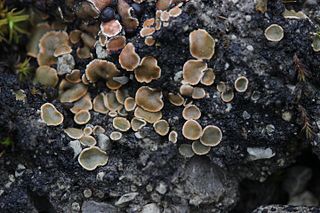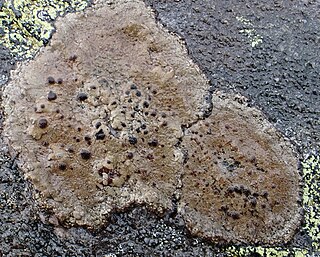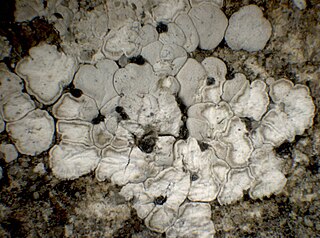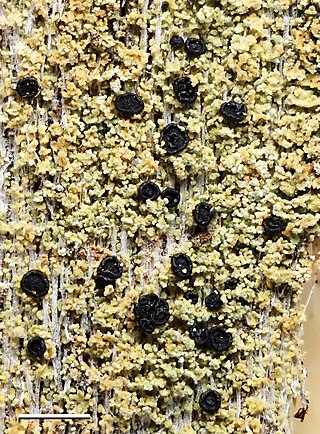
Psora is a genus of lichen-forming fungi in the family Psoraceae. Members of the genus are commonly called fishscale lichens. Lichens in the genus Psora generally have a squamulose thallus and anthraquinones in the hymenium. Photobiont partners of Psora lichens include members of the green algal genera Asterochloris, Chloroidium, Myrmecia, and Trebouxia.

Japewia is a genus of lichen-forming fungi in the family Lecanoraceae. The genus was circumscribed in 1990 by the Norwegian lichenologist Tor Tønsberg, who assigned J. tornoënsis as the type species. The new genus is named in honour of Peter Wilfred James, a notable lichenologist, with Japewia being derived from the first letters of his initials (Ja) and his surname (Pe) followed by a typical Latin suffix (-wia).

Pycnora is a genus of fungi in the monotypic family Pycnoraceae. It contains three species. The genus was circumscribed by Josef Hafellner in 2001; the family was proposed by Mika Bendiksby and Einar Timdal in 2013.

The Umbilicariales are an order of lichenized fungi in the subclass Umbilicariomycetidae, class Lecanoromycetes. It contains five families: Elixiaceae, Fuscideaceae, Ophioparmaceae, Ropalosporaceae, and Umbilicariaceae. Umbilicariales was proposed as a new order in 2007, while the subclass Umbilicariomycetidae was proposed in 2013.

Fuscideaceae is a family of fungi that form symbiotic] relationships with algae to create lichens. These lichens typically have a crust-like appearance and are found worldwide, though they are most common in temperate regions. The family includes five genera and about 55 species, which primarily grow on tree bark, rocks, or occasionally on wood or leaves. Fuscideaceae lichens are characterised by their reproductive structures, cup-like formations called apothecia, which can vary in colour from red to dark brown or black. The family has undergone several changes in its classification over the years, with recent genetic studies placing it within the order Umbilicariales. Fuscideaceae lichens produce various chemical compounds, some of which are unique to this family, and these chemicals are often used to help identify different species.

Hypocenomyce is a genus of lichen-forming fungi in the family Ophioparmaceae. Species in the genus grow on bark and on wood, especially on burned tree stumps and trunks in coniferous forest. Hypocenomyce lichens are widely distributed in the northern hemisphere.

The Tephromelataceae are a family of lichenized fungi in the order Lecanorales. The family was circumscribed by Austrian lichenologist Josef Hafellner in 1984. Tephromelataceae comprises the genera Tephromela, Calvitimela, Mycoblastus and Violella, which together constitute a well-supported monophyletic group.
Bibbya is a genus of fruticose lichens in the family Ramalinaceae.

Sporastatiaceae is a small family of crustose lichens in the order Rhizocarpales. It contains two genera, Sporastatia and Toensbergia, with a total of five species. Sporastatiaceae was circumscribed in 2013 by Mika Bendiksby and Ernst Timdal.
Toensbergia is a genus of lichen-forming fungi in the family Sporastatiaceae. The genus was circumscribed by Mika Bendiksby and Einar Timdal in 2013. The genus name honours Norwegian lichenologist Tor Tønsberg, "in appreciation of his important work on sorediate, corticolous lichens". The type species is Toensbergia leucococca, which was formerly classified in genus Hypocenomyce, presumably due to its resemblance to Hypocenomyce xanthococca.

The Rhizocarpales are an order of lichen-forming fungi in the subclass Lecanoromycetidae of the class Lecanoromycetes. It has two families, Rhizocarpaceae and Sporastatiaceae, which contain mostly crustose lichens.

Carbonicola is a small genus of lichen-forming fungi. It is the sole genus in the monogeneric family Carbonicolaceae. The genus, which collectively has an almost cosmopolitan distribution, contains three squamulose lichens that prefer to grow on burned wood in temperate areas of the world.
Phyllopsora concinna is a species of corticolous (bark-dwelling), squamulose (scaley) lichen in the family Ramalinaceae. Found in Central and South America, it was formally described as a new species in 2019 by lichenologists Sonja Kistenich and Einar Timdal. The lichen has a scaley, effuse (spread-out) thallus that is pale green with a well-developed, white prothallus. Apothecia occur rarely; they are brownish with a paler margin, measuring up to 1 mm in diameter. Ascospores are simple with a narrow ellipsoid to fusiform shape, and dimensions of 12.5–16·0 by 3.5–4.0 μm. Atranorin and parvifoliellin are major lichen products that occur in this species. The latter compound distinguishes it chemically from the morphologically similar species Phyllopsora cinchonarum, which instead contains lobaric acid. The botanical name concinna, refers to its "beautiful" appearance.
Placolecis kunmingensis is a species of saxicolous (rock-dwelling), crustose lichen in the family Catillariaceae. It is found in Yunnan, China. The lichen is characterised by a thallus that is areolate to squamulose in its centre, forming irregular patches or clumps 10–50 mm wide, as well as its ellipsoid or spherical ascospores with slightly thickened wall.

Porpidinia is a genus of lichen-forming fungi in the family Lecideaceae. It has two species of saxicolous (rock-dwelling) lichens. The type species of the genus, Porpidinia tumidula, thrives in a variety of settings from coastal to mountainous areas, primarily on lime-rich rocks, and is widely spread across southern to northern Europe, northern Africa, parts of Asia, and New Zealand. Meanwhile, Porpidinia brevispora is more regionally confined, found specifically in the Sikhote-Alin range in the Russian Far East, favouring carbonate rocks at lower altitudes.

Xylopsora canopeorum is a squamulose (scaly), corticolous (bark-dwelling) lichen species in the family Umbilicariaceae. Discovered in the canopies of Sequoia sempervirens in California, United States, it was formally described as new to science in 2018. It is endemic to the central coastal region of California, living within the unique ecosystems of Big Basin Redwoods State Park and Armstrong Redwoods State Natural Reserve, areas known for their ancient coast redwood forests. The lichen evolves from a crust-like to scale-like form, developing into coral-like crusts as it matures, complemented by distinctive flat, black reproductive discs. This species has varying greyish-green to medium brown coloration and occasionally forms soralia, which release powdery reproductive propagules called soredia. Xylopsora canopeorum is distinguished from closely related species by its smaller, partly coral-like squamules (scales), the occurrence of soralia on its surface, and in some specimens, the presence of both thamnolic and friesiic acids within the thallus.
Lecidea toensbergii is a species of saxicolous (rock-dwelling), crustose lichen in the family Lecideaceae. Described as a new species in 2018, it has been documented from several locations in Norway and a single location in Sweden, where it grows in rocky alpine environments.

Romjularia is a fungal genus in the family Lecideaceae, containing the single species Romjularia lurida, a saxicolous and terricolous squamulose lichen.
Meridianelia is a fungal genus in the family Elixiaceae. It consists of the single species Meridianelia maccarthyana, a corticolous (bark-dwelling), crustose lichen. This lichen forms greyish-white, crust-like growths on tree bark in subalpine woodlands of Tasmania, Australia. Discovered in 2003 and scientifically described in 2009, Meridianelia is classified in the small fungal family Elixiaceae based on its genetic and structural characteristics. The genus is notable for its unique reproductive structures and its apparent rarity, having been found in only a few locations despite growing in a relatively common type of forest.
Boreoplaca is a fungal genus in the family Ophioparmaceae. It comprises the single species Boreoplaca ultrafrigida, a saxicolous (rock-dwelling), squamulose lichen. Both the genus and species were described in 1994 by the Norwegian lichenologist Einar Timdal. The lichen is found in Eastern Siberia, the Russian Far East as well as in adjacent territories of north-east China, and in South Korea. The main characteristics of the lichen are its squamulose thallus, black lecideine apothecia, and Fuscidea-type asci.












